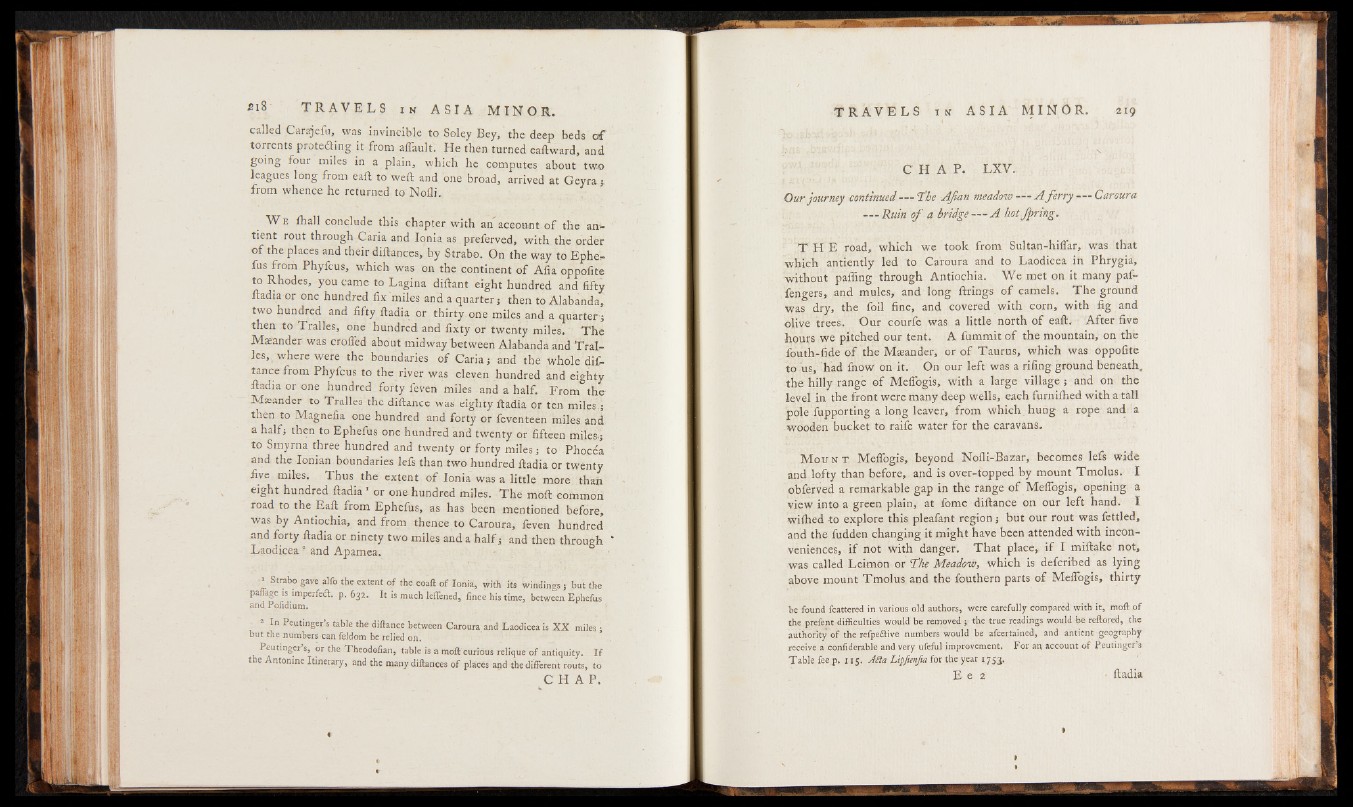
called Carajefu, was invincible to Soley Bey, the deep beds a f
torrents protefting it from alfault. He then turned eaft ward, and
going four miles in a plain, which he computes about two
leagues long from eaft to weft and one broad, arrived at Gey raj
from whence he returned to Nofli.
W e fhall conclude this chapter with an"account of the an-
tient rout through Caria and Ionia as. preferved, with the order
of the places and their diftances, by Strabo. On the way to Ephe-
fus from Phyfcus, which was on the continent of Afia oppofite
to Rhodes, you came to Lagina diftant eight hundred and fifty
ftadia or one hundred fix miles and a quarter* then to Alabanda,
two hundred and fifty ftadia or thirty one miles and a quarter*
then to Tralles, one hundred and fixty or twenty miles. The
Maeander was crofted about midway Between Alabanda and Tralles,
where were the boundaries of Caria* and the whole difi.
tancefrom Phyfcus to the river was eleven hundred and eighty
ftadia or one hundred forty feven miles and a half. From the
Maeander to Tralles the diftance was eighty ftadia or ten miles:*
then to Magnefia one hundred and forty or feventeen miles and
a half* then to Ephefus one hundred and twenty or fifteen miles*
to Smyrna three hundred and twenty or forty miles* to Phocea
and the Ionian boundaries lefs than two hundred ftadia or twenty
five miks. Thus the extent of Ionia was a little more than
eight hundred ftadia or one hundred miles. The moft common
road to the Eaft from Ephefus, as has been mentioned before,
was by Antiochia, and from thence to Caroura, feven hundred
nnd forty ftadia or ninety two miles and a half * and then through
Laodicea* and Apamea.
t Strabo Save a,fo the extent of the coaft of Iorvia, with its windings * but the
pa age is imperfect, p. 632. It is much leftened,' fince his time, between Ephefus
and Pofidium.
In Peutinger s table the diftance between Caroura and Laodicea is XX miles;
but the numbers can feldom be relied on.
Peutinger s, or the Theodoftan, table is a moft curious relique of antiquity. If
t e Antonine Itinerary, and the many diftances of places and the different routs, to
C H A P . LXV.
Our journey continued —- The -Afian meadow — A ferry — Caroura
— Ruin of a bridge— A hot faring.
T H E road, which we took from Sultan-hiffar, was that
which antiently led to Caroura and to Laodicea in Phrygia,
without paffmg through Antiochia. We met on it many paf-
fengers, and mules, and long firings of camels. The ground
was dry, the foil fine, and covered with corn, with fig and
olive trees. Our courfe was a little north of eaft. After five
hours we pitched our tent. A fummit of the mountain, on the
fouth-fide of the Maeander, or of Taurus, which was oppofite
to us, had fnow on it. On our left was a rifing ground beneath,
the hilly range of Meffogis, with a large village ;'-and on the
level in the front were many deep wells, each furnifhed with a tall
pole fupporting a long leaver, from which hung a rope and a
wooden bucket to raife water for the caravans.
M o u n t , Meffogis, beyond Nofli-Bazar, becomes lefs wide
and lofty than before, and is over-topped by mount Tmolus. I
obferved a remarkable gap in the range of Meffogis, opening a
view into a green plain, at fome diftance on our left hand. I
wifhed to explore this pleafant region * but our rout was fettled,
and the fudden changing it might have been attended with inconveniences,
if not with danger. That place, if I miftake not,
was called Leimon or The Meadow, which is defcribed as lying
above mount Tmolus and the fouthern parts of Meffogis, thirty
be found fcattered in various old authors, were carefully compared with it, moft of
the prefent difficulties would be removed ; the true readings would be reftored, the
authority of the refpedtive numbers would be afcertained, and antient geography
receive a confiderable and very ufeful improvement. For an account of Peutinger’s
Table feep. 115. A d a Lipfimfia for the year 1753.
E e 2 ftadia